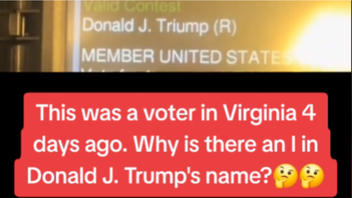Showdown in Arizona: Will Kari Lake Prevail in Her Election Lawsuit?
December 12, 2022
When the win forecast in pre-election polling for Arizona Republican gubernatorial candidate Kari Lake did not materialize on Election Day, the tabulator and printer issues in Maricopa County were widely believed to be the culprit. These widespread issues in Maricopa County were expected to form much of the basis of the Lake campaign’s anticipated challenge to the election, though what additional claims form the basis of the suit was anyone’s guess. The suspense ended on December 9, 2022, when Lake filed her formal election contest in Maricopa County Superior Court. The issues raised with the 2022 Arizona elections are far more extensive, and troublesome, than the tabulator/printer issues alone.
A basic understanding of the litigation, the claims, and the applicable law will inform readers. Election contests in Arizona are governed by Article 13 of Title 16 of the Arizona Revised Statutes. ARS §16-672 deals specifically with contests of state elections. This statute sets forth multiple grounds for challenges to state elections, including misconduct of election boards or officers involved in the canvass, illegal votes, and erroneous count of votes, among others. The challenge filed by Lake implicates several of these provisions. While the election contest suit itself totals 70 pages, the fundamental claims may be distilled down to a handful of major issues.
Misconduct and Illegal Votes
The election contest alleges that several separate actions or omissions on the part of elections officials constitute “misconduct” within the meaning of the Arizona statute. The suit also alleges that multiple categories of illegal votes were erroneously included in the canvass. Finally, the suit alleges Federal Equal Protection and Due Process violations.
Among the claims made in the suit:
(1) The tabulator and printer errors encountered by Election Day voters in Maricopa County were far more widespread than the county claimed, causing extraordinarily long wait times at vote centers all over the county, resulting in disenfranchisement of in-person voters who favored Lake by a 3-to-1 margin. The allegations are based, in part, on declarations of numerous poll-watchers, Maricopa election workers, voters, RNC “roving” attorneys, and an expert affidavit from Rich Baris. The number of disenfranchised voters is alleged to be substantially in excess of the 17,000-vote margin separating Lake and Hobbs.
(2) The tabulators and printers used in Maricopa are claimed to be uncertified in violation of ARS §16-442 (which requires the equipment to be certified and in compliance with the Help America Vote Act of 2002), based on the declaration of cyber-expert Clay Parikh, who spent nine years performing security tests on vendor voting systems for the U.S. Elections Assistance Commission. Parikh is also of the opinion that the widespread nature of the tabulator and printer problems in Maricopa is such that the problems could not arise “absent intentional misconduct.”
(3) many of the voters who encountered the tabulator or printer “malfunctions” on Election Day were prompted to place their ballots in “Door 3,” which was for uncounted ballots. According to the Maricopa County Election Procedure Training Manual, the Door 1 & 2 ballots (which were counted by the tabulators already) were supposed to be separated from the Door 3 uncounted ballots and transported separately. Some of the “Door 3” uncounted ballots, however, were mixed in or commingled with counted ballots. These errors allegedly deprived thousands of voters of their votes and resulted in double-votes.
(4) The Maricopa County elections officials failed to adhere to the signature verification requirements of ARS §16-550 with respect to early ballots. The suit alleges grave errors in the process, based on Maricopa County elections workers who were involved. Election workers attest that 35–40% of signatures were being rejected, only for the ballots to be “re-reviewed” multiple times by individual workers, without oversight, who routinely approved the signatures. (If these unsupervised, standardless signature approvals are proved at trial, the potential for federal equal protection violations looms. See Bush v. Gore.) The suit also contends that a third-party contractor called “Star Center” handled ballot “curing” without any oversight or observation.
(5) The Maricopa County officials failed to generate and maintain the chain-of-custody (COC) documentation required for drop box votes. The COC requirements were mandated by ARS §16-621(E) and by the 2019 Elections Procedure Manual, at pages 61–62 (the 2019 manual applied because of disagreement between the state A.G. and SOS Hobbs and litigation over the 2022 manual). These issues stem from Maricopa County’s use of a third-party contractor called Runbeck, which scanned the early ballots to obtain electronic images of the signatures. The suit alleges that Maricopa County could not produce COC documentation for nearly 300,000 early ballots. The claims are based on Maricopa County’s responses to public records requests made by the Lake campaign, as well as declarations from a Runbeck employee and election-observers.
(6) The suit further alleges First Amendment violations and conflicts of interest against secretary of state Katie Hobbs and Maricopa official Stephen Richer. Secretary Hobbs apparently worked with social media companies to suppress the free speech of those with opposing political viewpoints, while Richer started a political action committee to work with NeverTrump-type candidates and other PACs opposed to Lake specifically.
The election contest filed by Kari Lake also pleads federal claims, including equal protection, substantive due process, and procedural due process violations. The primary issues delineated above form the basis of the federal claims as well.
The suit contains many more details pertaining to each of the claims outlined above, as well as additional claims and contentions omitted from this article. Take the time to read the entire formal election contest. The petition also includes detailed descriptions of the ways to vote in Arizona and of the vote-counting process and is worth a read.
The Requested Remedies
Kari Lake’s election contest suit seeks several different forms of relief. Specifically, Lake requests the ability to inspect all ballot signature envelopes and to conduct a “root cause analysis and forensic examination” of the tabulator-printer issues. The suit requests that all invalid ballots and types of ballots be stricken outright or on a pro-rata basis and that Lake be declared the winner or a new election held. If a new election is held, Lake requests that Secretary Hobbs and county recorder Richer be prohibited from oversight of it.
The pro-rata reduction request warrants explanation. In a case called Huggins v. Superior Court, the Arizona Supreme Court adopted a “pro-rata” reduction approach when illegal votes are cast in an election. The illegal votes are backed out proportionally to the votes received by each candidate. Here, Lake’s campaign challenges only drop box and early mail votes as illegal and will, undoubtedly, request that the pro-rata reduction apply in the proportion to which early votes were cast (which will cost Hobbs the election). In the Huggins case, however, the Arizona Supreme Court specifically reserved the question of what to do “when proration would change the election result.” Thus, the proper remedy in the event that Lake wins her election contest is simply not clear.
Election contests are never easy, and this one is no exception. The claims made here are serious. The evidence already gathered and compiled is substantial, with more undoubtedly being gathered every day. The parties will slug it out in court. Arizona is not the Wild West anymore, but this litigation is about as close to the gunfight at the OK Corral as we are likely to get in these times. Stay tuned.
Daniel R. Street is an attorney with over 25 years of litigation experience. He is the author of the Fake News Exposed about Trump book series. Check out his website at danielrstreet.com.

Image: Kari Lake. Credit: Gage Skidmore via Flickr, CC BY-SA 2.0.



